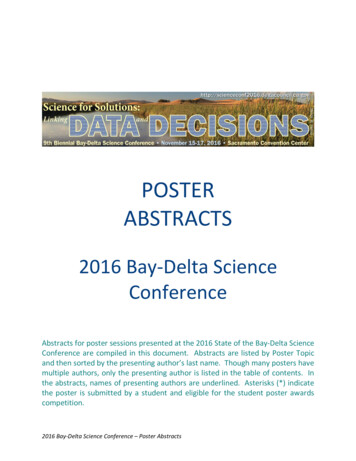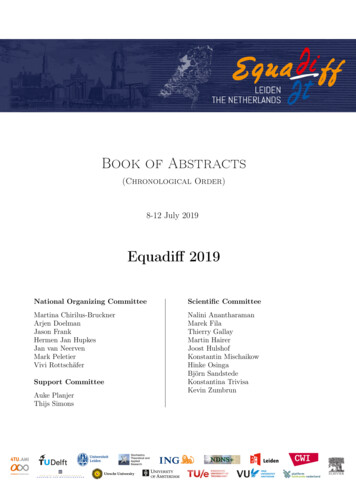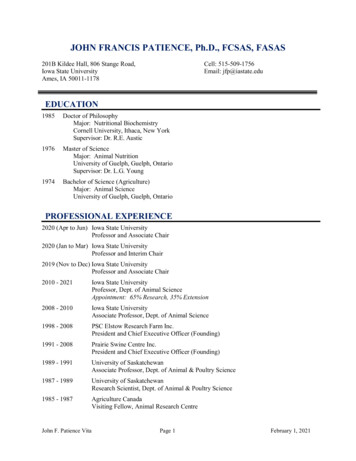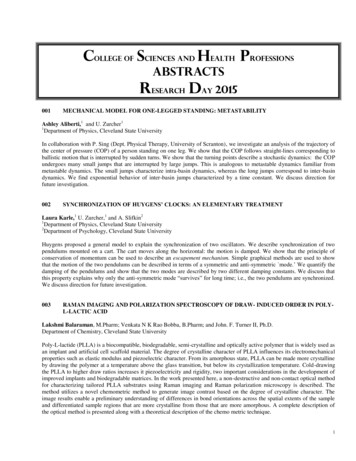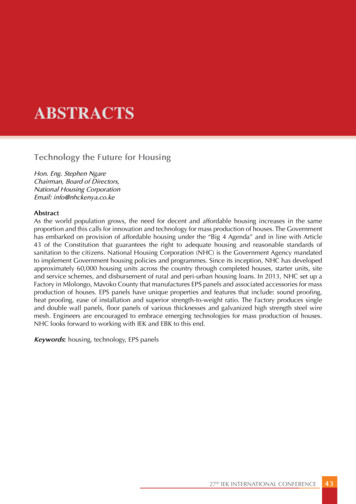
Transcription
ABSTRACTSTechnology the Future for HousingHon. Eng. Stephen NgareChairman, Board of Directors,National Housing CorporationEmail: info@nhckenya.co.keAbstractAs the world population grows, the need for decent and affordable housing increases in the sameproportion and this calls for innovation and technology for mass production of houses. The Governmenthas embarked on provision of affordable housing under the “Big 4 Agenda” and in line with Article43 of the Constitution that guarantees the right to adequate housing and reasonable standards ofsanitation to the citizens. National Housing Corporation (NHC) is the Government Agency mandatedto implement Government housing policies and programmes. Since its inception, NHC has developedapproximately 60,000 housing units across the country through completed houses, starter units, siteand service schemes, and disbursement of rural and peri-urban housing loans. In 2013, NHC set up aFactory in Mlolongo, Mavoko County that manufactures EPS panels and associated accessories for massproduction of houses. EPS panels have unique properties and features that include: sound proofing,heat proofing, ease of installation and superior strength-to-weight ratio. The Factory produces singleand double wall panels, floor panels of various thicknesses and galvanized high strength steel wiremesh. Engineers are encouraged to embrace emerging technologies for mass production of houses.NHC looks forward to working with IEK and EBK to this end.Keywords: housing, technology, EPS panels27th IEK INTERNATIONAL CONFERENCE43
STREAM 1Sub-Theme 1:Engineering the SustainableDevelopment Goals (SDGs)Paper 1: Session 1(S1) – 1.1PROCESS MODELING OF A MEDICAL VENTILATOR USING CYBERPHYSICAL SYSTEMS1*11121J.B Byiringiro , P.N Kioni , A.C Kibor , P.K Rono , H. Smajic , F.I Maina1Siemens Mechatronics Training and Certification Centre, Dedan Kimathi University of Technology,Private Bag–10143, Dedan Kimathi, Nyeri Kenya;2Faculty of Vehicle Systems and Production, Institute of Production (IFP), Technology Arts ScienceTHKoln, 50678 Köln, Germany*Corresponding author: jean.bosco@dkut.ac.ke; Tel.: 254-716-150-627AbstractRecent innovations in the medical ventilator development have begun to radically change traditionalengineering practices towards Cyber-Physical Systems (CPS). Early this year, public and privatehospitals procured a number of medical ventilators from various manufacturers as one the responses toCOVID-19 pandemic. A core challenge associated with medical ventilators procured is maintenanceand troubleshooting of the control systems due the gap between technologies used by the manufacturers.Currently the cost of maintaining a standard intensive care unit (ICU) ventilator skyrocketed with over200% leading unsuccessful fight against COVID19 and other acute respiratory diseases (ARDs). Virtual Reality (VR) may contribute to this endeavor,since this technology is inherently suitable to visualize medical ventilator and allows intuitive userinteractions within a highly immersive virtual environment. In one hand this paper presents a low costphysical medical ventilator (MV001-2020) that delivers breaths in real time via controlled proportionalpressure and flow regulator valves driven by a Programmable Logic Controller (Siemens PLC S71214DC/DC/DC). On the other hand, a virtual model of the medical ventilator that monitor and control clinicalparameters such as tidal volume, Oxygen-Air-mixture (FiO2(), Frequency /breaths per minute (bpm)),Inhalation/Exhalation(I/E) ratio. Alarms are set via a user-friendly cyber and physical touch screenHuman Machine Interface (HMI) based on SIMATIC HMI (KTP700) display. The ventilator featurestwo control modes: Volume controllers11(VC-CMV) and pressure controlled (PV-CMV). Through theprototype, the following parameters were successfully set and tested: tidal volume of 200 800mmHgat 50 steps increment, bpm of 10 30 at 2 values increment, flow rate of 4 50l/min, FiO 2 of21 100% and a peak pressure of 60 cmH2O.Keywords: Cyber-Physical Systems, Virtual Reality, Medical Ventilator, Programmable LogicController, Human Machine Interface4427th IEK INTERNATIONAL CONFERENCE
Paper 2: Session 1(S1) – 1.2Pump Stations: Dealing with the Non-Revenue Power in WaterDick NdiewoDitech Engineering LimitedEmail ndiewo@ditech.co.keAbstractNo water utility operates a self-sustaining business in Africa. This is due to many factors like high nonrevenue water, incompetence, high energy bills and poor choice of equipment. While Non-RevenueWater Projects have received a lot of attention and rightly so, energy audit has not. The life cyclecost of a pump consists of 20% and 80% capital and operational costs, respectively. Operational andmaintenance costs can be divided as staff, parts, and energy. In rational environment little can be doneto reduce staff and parts costs, but energy can be managed by installing high efficiency equipment.Unfortunately, Africa happens to have the highest energy charges in the world making the situationworse. Towards this end scientists and engineers have come up with many solutions including solarpower plants, power factor correction capacitors, better pump designs, soft starters, variable frequencydrives, permanent magnet motors, IEE motor classification. These are aimed at delivering more reliable,cost effective, highly efficient, and longer lasting equipment. Despite the progress practitioners, todate grapple with challenges such as diversity of the field, high energy costs, outdated technology,poor understanding of equipment, inexperience, language barriers, corruption, and poor knowledge ofContract Management. This paper explores the various scenarios that can be employed to address theenergy challenge in the water and sewage pumping industry.Keywords: Efficiency, Life Cycle Cost, Energy AuditPaper 3: Session 1(S1) – 1.3Design of Durable Concrete Mixes for Reinforced Concrete StructuresGladwell Wanjiku Nganga, Siphila Wanjiku Mumenya and Silvester Ochieng Abuodha Department ofCivil and Construction Engineering, University of Nairobi,P.O. Box 30197 - 00100, NairobiAbstractIn the construction industry, there are growing concerns with the use of concrete due to: i) its carbonfootprint arising from the high CO2 emissions during the production of clinker, the main constituent ofcement, and, ii) lack of durability of reinforced concrete (RC) structures resulting in costly repairs andrehabilitation. Various approaches of reducing emissions from clinker production have been implementedby cement manufacturers. A further approach proposed for reducing this carbon footprint is a reduction ofclinker (effectively cement) content in concrete. The reduction of clinker content, however, is not readilyfeasible in most design standards as a minimum cement content is required for durability. This prescriptiveapproach has several limitations which has resulted in a shifted to a performance-based approach whereboth the compressive strength and durability are determined. This paper is based on an ongoing studythat proposes such a shift from the prescriptive approach in Kenya. An overview is given on the datacollection stage that involved the use of a research questionnaire with an aim of determining designapproach for durability. The respondents were various parties involved in design and construction of RCstructures. General observations revealed that majority of the respondents were concerned about the lackof durability of RC structures. This was mainly attributed to poor workmanship.Keywords: sustainability, reinforced concrete (RC), durability, performance-based approach, interviews,specifications27th IEK INTERNATIONAL CONFERENCE45
Paper 4: Session 2(S1) – 2.1Paradigm Shift in Linking Engineering with the Roots; Engineering theFood Security AgendaEng. Ndambuki Kilonzo1,2, Eng. Paul Karara Ngunjiri1,3, Nathan Yego1,41Agriculture sub-committee-Policy Research and Advocacy Committee, IEK2Agricultural Engineering Dept, Kenyatta University, P.O Box 43844-00100, Nairobi.3Oville Associates, P.O. Box 56272 Nairobi 002004Mechanical Engineering Dept, JKUAT, P.O. Box 62000-00200, NairobiAbstractThe Government development blueprints, the Big Four Agenda and Vision 2030 seek to catapult developmentthrough food security amongst others. Realization of the food security agenda has been hampered by anumber of factors including; inadequate funding for irrigation developmental projects, the threats of famineand drought occasioned by climatic changes leading to failed rainfed agriculture, runaway corruption wherefunds earmarked for irrigation related projects are diverted or just embezzled, and shifting food habits fromtraditional staple foods. The growth of a strong environmental and public good lobby group has also madethe planning and execution of large projects an Engineers nightmare. Cognizant of the need for a paradigmshift, the Agricultural Sector Transformation and Growth Strategy, 2018-2028 aims to move “TowardsSustainable Agricultural Transformation and Food Security in Kenya. Two recent interventions to demonstratethis shift in policy thinking are the; “one million Home/Kitchen Garden Project” and the World Bank fundedSmall Irrigation value addition project (SIVAP). The need for secure food systems has been magnified by theCovid19 pandemic which left families poorly exposed to vagaries of hunger due to disruption of marketand transport systems. In order to be in tandem with the foregoing, it’s imperative that engineers rethinktheir approach to application of engineering principles from large scale high impact almost guaranteed tofail projects to small, time tested undertakings which have a much higher chance of success, are easily upscalable and cost effective.Keywords: Food security, sustainable, technology, youthPaper 5: Session 2(S1) – 2.2Underground Spaces Construction Technology and its Impact PostCOVID-19 Pandemic in KenyaD. Maina1,3, D.Mauti1, J.Muchiri1, B.Alunda1, V.Rono2,31School of Mining and Engineering, Taita Taveta University, Kenya2Athi Water Works Development Agency (AWWDA)3Tunnelling Association of Kenya (TAK)AbstractUnderground spaces and other subsurface infrastructure like shopping malls, sewer lines and nuclear wastestorage repositories are becoming increasingly important for society’s development. Recently, many cities andtowns in Kenya and around the world are being overrun spatially by rapid urban population growth, boomingmetropolises, scarcity of urban land, environmental awareness, as well as an increase in specific needs forprotection, storage, security, and sheltering, have all contributed to the use and development of undergroundspaces population growth and the movement of the people from rural to urban areas has resulted in significantdemands for growth in city infrastructures, especially in megacities throughout the world. Such growth canonly be supported by the efficient use of underground space. This paper explores the impacts of undergroundinfrastructure on social, environmental and economic in Kenya in relation to COVID-19 pandemic. Two casestudies will be evaluated in this paper to demonstrate the impacts gained so far.Keywords: Subsurface infrastructure, COVID-19 pandemic, impacts gained4627th IEK INTERNATIONAL CONFERENCE
Paper 6: Session 2(S1) – 2.3Role of Nuclear Energy in Combating Climate ChangeEng. Collins Gordon Juma, MBS Chief Executive Officer Nuclear Power and Energy Agency andImmediate Past IEK President; Email: jugoco3@gmail.com Phone: 0722525890*Chesire Kipkemboi Edwin, National Liaison Assistant Nuclear Power and Energy AgencyEmail: cedwin@nuclear.co.ke; chesireedwin@gmail.com Phone:0723696146*Corresponding AuthorAbstractClimate Change has become a subject of national, regional and international discussion. The effects arebeing felt currently. The Energy Sector has had a role in contributing to Climate Change in the wholeworld. The complementary role of Nuclear energy, hydropower and renewables is key in ensuring a lowcarbon economy by 2050. It is stated that between the periods 1970-2013, this combination has helpedin avoiding the emissions of about 163 Gt of CO2 emissions in total. Hydropower accounted for 53%(87Gt CO2) and Nuclear Power contributed 41% (66 Gt CO2) and other renewables saved 6 % (10GtCO2). Nuclear power has been considered to have the potential to meet the climate change challenge byproviding electricity for domestic and for industrial processes, generated with almost zero greenhouse gasemissions. The potential role for Nuclear has also been cited in the Intergovernmental Panel on ClimateChange (IPCC) Special Report on global warming of 1.5 oC. This paper will enumerate the importance androle of Nuclear Energy in meeting the climate change goal in the country and world over.Key Words: Nuclear Energy, Climate Change, Green House GassesWelcome to the Silicon SavannahKonza Technopolis, Africaʼs smartestinvestment destination will host the most creative, impactfultechnology that will disrupt industries and transform lifestyles.Designated as a Special Economic Zone (SEZ), the Technopolis provides unparalleledopportunities to deploy game changing technologies, make data driven decisions and deploysustainable smart water and energy use that will lower the cost of doing business and open up economicopportunities for Africa. Most of residential parcels in Phase One have already been taken.All our parcels are fully serviced, with a plug and play utilities feature. The Kenya Advanced Institute of Science andTechnology (KAIST), Africa's most forward university, has began. A world class Digital Media City is on course. 262 acres ofnature parks and recreational areas, keeping Africaʼs promise of everyday interaction with nature are set.Weʼre building the city of the future!Opportunities available in:Smart Manufacturing,Light Industry & LogisticsSmartAgricultureICT & ITEnabled servicesPropertydevelopmentProductdevelopment& innovationR&D CentresMedical &PharmaceuticalservicesMedia &information servicesHotels &Convention CentresEntertainment,recreation andsports facilitiesBusinessenterprisesEducation &training institutionsVisit us on www.konza.go.ke or write to us at invest@konza.go.ke or speak to Ms. Anna Wafula, t he sales manager, 254 722 617 053SIEMENS TRAINING CENTRE AT DEDAN KIMATHI UNIVERSITY OF TECHNOLOGYWelcome to the pioneering Siemens MechatronicCertification Centre in Africa. We are located at DedanKimathi University of Technology (Main campus), NyeriCounty.This Centre is also accredited by the Engineers Board of Kenya(EBK), to offer virtual Machines Control (VMC) as a ContinuingProfessional Development (CPD) for registered professionalengineers and also engineering consulting firms.A world leader in Mechatronic engineering & industrialautomation, Siemens AG has collaborated with DedanKimathi University of Technology to address a globaldemand of mechatronic engineering skills for the Industry4.0 revolution.VIRTUAL MACHINES CONTROLA core challenge of research associated with Industry 4.0 andCPS is to bridge the gap between the physical and digitalworld. Virtual Reality (VR) may contribute to this endeavor,since this technology is inherently suitable to visualizedigital contents and allows intuitive user interactions withina highly immersive virtual environment.Since 2016, we have offered Siemens Mechatronic SystemsCertification Program (SMSCP), an international industrystandard, comprehensive skills certificate in mechatronicsystems, in partnership with Siemens SITRAIN Germany.For enquiries contact:DEDAN KIMATHI UNIVERSITY OF TECHNOLOGYPrivate Bag 10143, Dedan Kimathi Tel: 061-2050000Cell: 254 713 835965; Email: registraraa@dkut.ac.keThe most important features of CPS are the high degree of(partial) autonomy, network communication, the ability topersonalize it and general user-friendliness.Cell: 254 716 150627; Email: smscp.kenya@dkut.ac.kewww.dkut.ac.keCell: 254 713 123021; Email: marketing@dkut.ac.keCell: 254 710 127516; Email: directornairobi@dkut.ac.ke
Sub-Theme 2:Big four Agenda and Vision 2030Paper 7: Session 3(S1) – 3.1Applicability of Public Private Partnerships in Development of Low-costHousing to Meet Kenya Vision 2030 and Related GoalsDr. Daniel Mutegi Giti, Principal Housing Officer, State Department for Housing, Nairobi.AbstractArticle 43 1 (b) of the constitution of Kenya, vision 2030, big four agenda and international conventions,like Sustainable Development Goals and the New Urban Agenda, obligates the government to provideadequate, accessible, decent and quality housing for citizens. The country has sought the applicationof the best strategies to address this requirement, especially low cost housing, because the currentdemand for housing stands at 250,000 units per year, while supply remains at 50,000 units p.a, hencedeficit of 200,000. Application of Public Private Partnerships (PPPs) has emerged as one of the mostplausible option. This study utilized three rounds of Delphi method to gauge the prospects of providinglow cost housing through application of PPPs. 88 respondents of housing practitioners, financiers anddevelopers were used, where it was found out that there are high prospects for applying PPPs in housingdelivery. It was concluded that PPPs are applicable in the provision of low cost urban housing, and assuch the country should embrace its application.Keywords: Public Private Partnerships, low cost housing, Delphi method.Paper 8: Session 3(S1) – 3.2KenGen CSR Project to Expand Naivasha Hospital during the Covid-19Pandemic by Construction of an Outpatient Departmental Complex.Eng. Moses Nthiga,Project Manager, KenGenAbstractNaivasha hospital receives about 600 outpatients daily from Nakuru and the surrounding counties.This number is projected to increase to 2,000 by 2030 due to existing developments and the plannedinfrastructure projects in the area. There is no dedicated outpatients’ facility. The objective of this projectis to expand and modernize the Naivasha public hospital to cater for the current and future outpatientservices. KenGen being a major investor at Naivasha in the Olkaria Geothermal Complex, offered KES300 Million as Corporate Social Responsibility and assist in executing this project. This was announced bythe President of Kenya on 14/12/2018 while officiating a geothermal power project at Olkaria. The CountyGovernment was to design the required hospital buildings and provide the balance of funds while theNational Ministry of Health would provide medical equipment. Tendering for the project was conductedand awarded through national competitive process for citizen contractors. Construction commenced on14/4/2020, despite the prevailing Covid-19 pandemic. Management of Covid-19 is a major concern at theconstruction site, but sufficient control measures have been engaged. Construction has progressed wellahead of schedule. All super structural work and walling is complete in readiness for roofing.Keywords: Big four agenda, health Care, KenGen CSR, Naivasha hospital, Out-Patient DepartmentalBlock,4827th IEK INTERNATIONAL CONFERENCE
Paper 9: Session 3(S1) – 3.3Post-COVID Economic recovery: Rethinking Kenya’s road infrastructuredevelopment modelMargaret Ogai1; Timothy Oketch2; Evelyne Kihiu3; James Gachanja31General Manager Planning & Programming, Kenya Roads BoardDirector – TIMCON Associates2, KIPPRA3AbstractInfrastructure comprises public facilities in a nation, including roads, railways, national buildings andpower lines. Good infrastructure raises productivity and lowers the cost of doing business (OECD, 2002).Poor infrastructure impedes a nation’s economic growth and international competitiveness. In Kenya, only58% of the citizens have access to basic drinking water, 30% have access to basic sanitation while 25%do not access to electricity and 30% are not served by an all-weather road. Under Kenya’s developmentplan, Vision 2030, infrastructure is identified as an enabler for Kenya’s economic development. However,COVID-19 pandemic has hit Kenya’s economy hard disrupting its recent broad-based growth path. Realgross domestic product (GDP) is projected to decline from an annual average of 5.7% (2015 – 2019)to 1.5%- in 2020 (World Bank, 2020). Since over 90% of Kenya’s passenger and goods are transportedby road, this sector is critical to the post COVID economic recovery strategy. This paper will examinethe policy and institutional framework for roads infrastructure development and management over thelast decade, analyse the basic objectives of roads policies and assess the effectiveness of ongoing roadprograms in delivering Vision 2030 goals. The paper will discuss what kind of road infrastructure isnecessary, where it is best suited, and who is to benefit from it in post COVID era.Keywords: Road infrastructure, Vision 2030, post COVID-1927th IEK INTERNATIONAL CONFERENCE49
Sub-Theme 7:Climate Change ResiliencePaper 10: Session 4(S1) – 4.1Are Rainfall Intensities Changing, Could it be Climate Change and whatcould be the Impact on Engineering Hydrologic Design and Structures?Joshua Kiprotich Kibii and Emmanuel C. KipkorirDepartment of Civil and Structural Engineering, Moi UniversityP.O. Box 3900-30100 Eldoret, KenyaAbstractClimate change is a contentious topic. There is evidence of climatic shifts globally. The change in climate overtime is natural and expected. However, industrialization during the past century may have influenced variationsexceeding natural cyclic change. This paper presents findings on research done to determine if there has been asignificant change in intensity and amount of rainfall received in Eldoret town occasioned by recent flooding andto stimulate further research. Engineers have a duty in the determination of peak storm discharge for sizing ofhydrologic structures for safe conveyance of discharge. Hydrologic design use either empirical or deterministicmethods based on historical data. Based on the recent weather patterns, the question is whether the historicaldata can still be used as a basis for providing accurate possible future events for hydrologic design. Differentanalytical methods were formulated to investigate different rainfall indices for 50 years using data from EldoretMeteorological Station. Results are indicative of decreasing but more intense rainfall events with variationsexceeding natural climatic cycles previously experienced. Could this be climate change? Despite the localizednature of this research, it is indicative of the global change in rainfall trends being experienced.Keywords: Climate change, rainfall events, intensity, hydrologic design.Paper 11: Session 4(S1) – 4.2Climate Resilience for Hydro Power Projects at Project DevelopmentStageEng. Michael Kalumbu NsefuZambia Metrology Agency /University of LusakaAbstractOne predominant sector which has been cited in the Seventh National Development Plan launched in 2017 bythe Zambian government, is the energy sector. This is also in line with the Sustainable Development Goal No.7regarding infrastructure expansion and the provision of clean energy. Hydropower projects despite being arenewable energy source, it is site-specific which require huge investment and have long gestation periods. Thesecharacteristics expose hydropower projects to various uncertainties and risks such as economic, environmental,social, geological, regulatory, political, technological, financial, natural, and safety. The environmental risk is sopredominant in this energy sector if not appropriately managed, there is the potential of project failures. One ofthe risk factors of the environment is climate change. Sustainability has also become a critical and unavoidableissue in hydropower development due to climate change risks. Sustainable development is related to technoeconomic development along with preserving the environment. To mitigate this climate change risk, there is aneed for a comprehensive and well-designed Risk Management Framework/Model (RMF/RMM) to effectivelymanage the climate change risks and many others at the project development stage. This is a critical stage as whenrisk mitigation measures are well managed during feasibility, planning, and procurement, it enables minimizationor elimination of these risks impacts on hydropower projects on other project life cycle. Hydropower projects riskplanning with the integration of climate-resilient perspective it enhances the designing of infrastructure that hascapabilities to resist climate change.Keywords: Risks, Hydropower, Climate Change, Framework, Model, Impact5027th IEK INTERNATIONAL CONFERENCE
Sub-Theme 4:Development of National, County andRegional value chainsPaper 12: Session 4(S1) – 4.3Formulation of Sustainable Road Maintenance Policies in Counties: AStudy of Bomet CountyAdeline Cheptoo Nyole, County Government of Bomet, P.O. Box 19-20400, Bomet.AbstractThe 2016 Road Classification register has a total of 161,451.5 Km of classified roads in the country. Out of which121,456.4 (75.2%) Km are classified as class D and below. These roads, together with all unclassified roads fallunder the jurisdiction of County Governments. They form the majority of the road network within the country. Yetthe counties get only 15% of the total budget for road maintenance. This paper seeks to evaluate and understandthe measures taken by County Governments in ensuring sustainable maintenance of their large road networks.All while keeping up with the economic and political demand to increase rural access index with a very smallbudget. Bomet County is formulating a road maintenance policy and will be used as a case study for the paper.Bomet County has a total road network of 7573.8Km both classified and unclassified. The National Road Agenciesmanage 534 Km while the County Government of Bomet has in its jurisdiction the rest of the road network atotal of 7,039.8Km. The paper will explore; the best practices like the incorporation of the Roads 2000 Strategyin order to reduce cost, increase efficiency and include the community especially the youth, women and peopleliving with disabilities in road maintenance, the challenges that may face the county while trying to implement thepolicy and process through which the county plans to implement sustainable road maintenance projects, ensuringthe inclusivity of the community. The source of data will be from the County Government of Bomet departmentof Roads, Kenya Rural Roads Authority (Bomet Region), Kenya Roads Board (KRB), secondary data from variouspublic and private institutions and reviews from stakeholders.Keywords: Road Maintenance, Road Classification, Bomet County, Roads 2000 Strategy, Policy.Paper 13: Session 4(S1) – 4.4Integrity: A Tool for Competitive Advantage for Engineers in PostPandemicJoel Alfred MwendwaAbstractSince the first case of COVID-19 was reported in Kenya, the effects of the pandemic have been felt by and large.Businesses have closed down as many investors pull out of the markets which continued to exhibit poor andunpromising trends. The engineering sector has not spared by the pandemic either. Since the pandemic hit thecountry, the government cushioned spending so as to consolidate funds to address the pandemic. This resulted toprojects stalling due to nonpayment of certificates while other projects that had been planned to be undertakenhaving to be cancelled. Arising from the effects of the pandemic, the government and private sector are bothlooking for a comeback to resume operations (the new normal). As the government puts in place measures to revivethe economy, engineers will be key and must play key role as creators to ensure that key steps and milestones arecovered within reasonable time plans. As this happens, it’s envisaged that businesses and individuals will try asmuch as possible to normalize and recover economically within the shortest time possible. We all expect the waron graft on the other hand to be hyped more than before. This desire to quickly make margins may see engineersbeing on the wrong side of the law and eventually face criminal prosecution over corruption related allegations.The built environment is key to the economic growth of any nation but is also subject to complex web of corruptactivities which lowers the expected growth in the economy. This paper seeks to address the role of professionalsin the built environment in tackling graft in post COVID-19 pandemic.Keywords: built environment, engineering sector, pandemic27th IEK INTERNATIONAL CONFERENCE51
Paper 14: Session 5(S1) – 5.1Role of Big Four Agenda and Vision 2030 for Kenya’s SustainableDevelopmentEng. Peter MutindaAbstractKenya, like all other developing countries in the world, is faced with the task of working strategically towardsthe achievement of the United Nation’s Sustainable Development Goals (SDGs). These goals whose due date ofaccomplishment coincides with those of the national development blueprint, namely, the Kenya Vision 2030,have become a major focus of attention in the country. There are great areas of concern or priority areas that thecountry is focusing on as a strategic focus towards the achievement of the Kenya Vision 2030 and SDGs 2030.These strategic areas of focus have been isolated and declared, as the country’s “Big Four priority areas”. TheKenya Vision 2030 comprises of three key pillars; Economic, Social and Political. Foundations for the three pillarsconsist of Infrastructure; Information and Communications Technology (ICT); Science, Technology and Innovation(STI); Land Reforms; Public Sector Reforms; Labour and Employment; National Values and Ethics; Ending DroughtEmergencies (EDE); Security; Peace Building and Conflict Resolution. The “Big Four” Agenda is the Government’sset of priority programs and reforms, which will be implemented over a period of five years, that is, from 2018to 2022. The Big Four include; food security, affordable housing, manufacturing and affordab
44 27th IEK INTERNATIONAL CONFERENCE Sub-Theme 1: Engineering the Sustainable Development Goals (SDGs) Paper 1: Session 1(S1) - 1.1 PROCESS MODELING OF A MEDICAL VENTILATOR USING CYBER-PHYSICAL SYSTEMS J.B Byiringiro1*, P.N Kioni1, A.C Kibor1, P.K Rono1, H. Smajic2, F.I Maina1 1Siemens Mechatronics Training and Certification Centre, Dedan Kimathi University of Technology,
